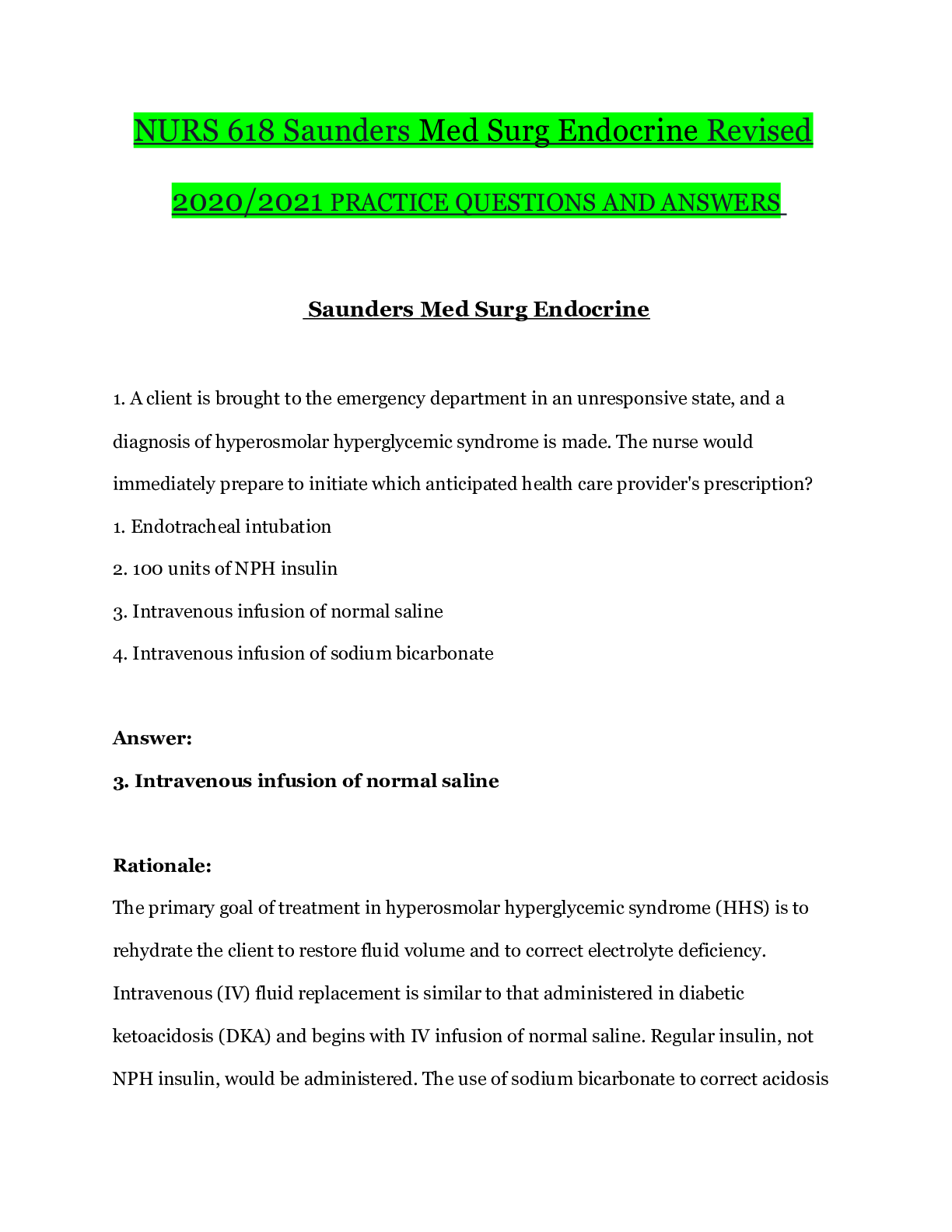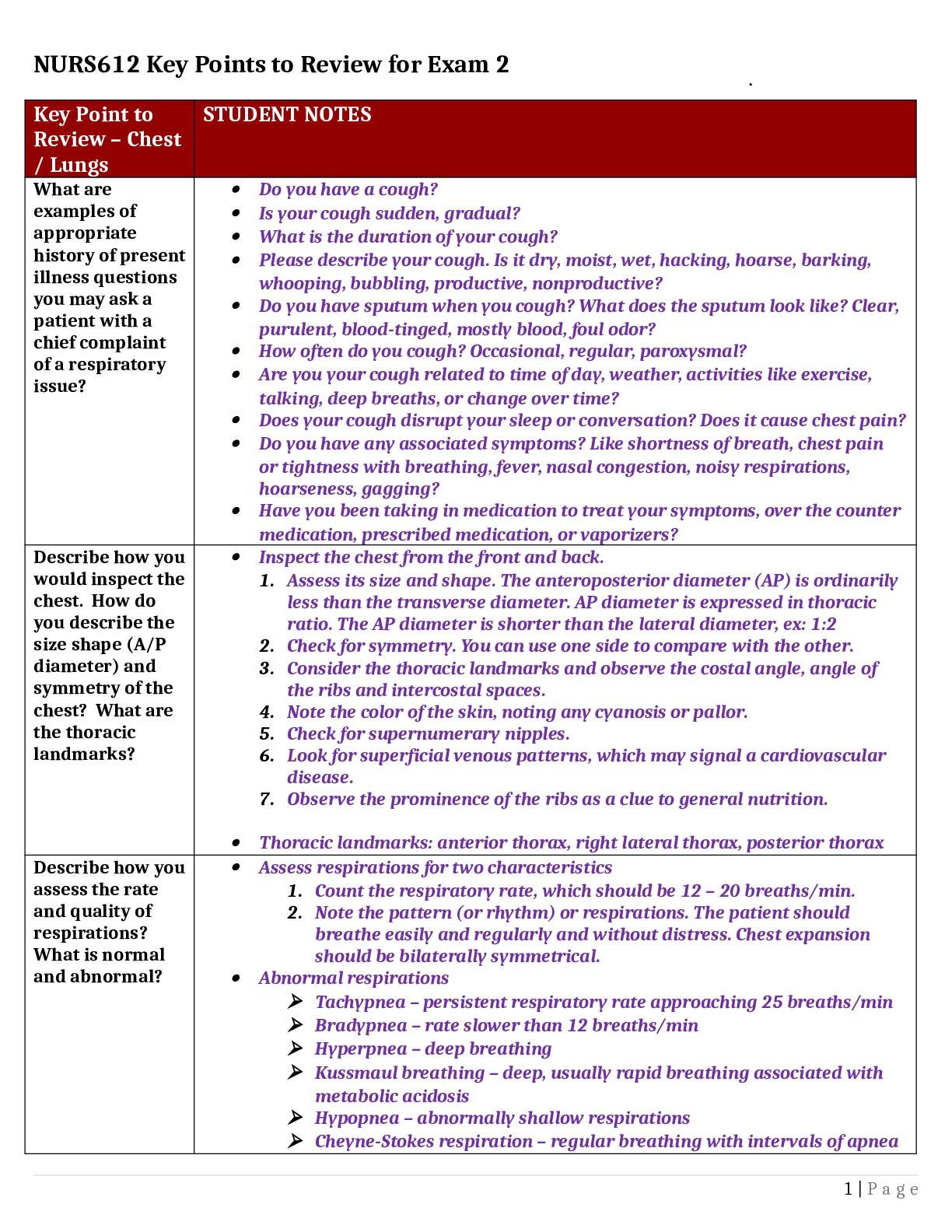
NURS 618 Saunders Med Surg Endocrine Revised 2020/2021 PRACTICE QUESTIONS AND ANSWERS
*NURSING > EXAM REVIEW > NURS612 Key Points to Review for Exam 2 / NURS 612 Key Points to Review for Exam 2 {A+ guide-2022} (All)
NURS612 Key Points to Review for Exam 2 Key Point to Review – Chest / Lungs STUDENT NOTES What are examples of appropriate history of present illness questions you may ask a patient with ... a chief complaint of a respiratory issue? Do you have a cough? Is your cough sudden, gradual? What is the duration of your cough? Please describe your cough. Is it dry, moist, wet, hacking, hoarse, barking, whooping, bubbling, productive, nonproductive? Do you have sputum when you cough? What does the sputum look like? Clear, purulent, blood-tinged, mostly blood, foul odor? How often do you cough? Occasional, regular, paroxysmal? Are you your cough related to time of day, weather, activities like exercise, talking, deep breaths, or change over time? Does your cough disrupt your sleep or conversation? Does it cause chest pain? Do you have any associated symptoms? Like shortness of breath, chest pain or tightness with breathing, fever, nasal congestion, noisy respirations, hoarseness, gagging? Have you been taking in medication to treat your symptoms, over the counter medication, prescribed medication, or vaporizers? Describe how you would inspect the chest. How do you describe the size shape (A/P diameter) and symmetry of the chest? What are the thoracic landmarks? Inspect the chest from the front and back. 1. Assess its size and shape. The anteroposterior diameter (AP) is ordinarily less than the transverse diameter. AP diameter is expressed in thoracic ratio. The AP diameter is shorter than the lateral diameter, ex: 1:2 2. Check for symmetry. You can use one side to compare with the other. 3. Consider the thoracic landmarks and observe the costal angle, angle of the ribs and intercostal spaces. 4. Note the color of the skin, noting any cyanosis or pallor. 5. Check for supernumerary nipples. 6. Look for superficial venous patterns, which may signal a cardiovascular disease. 7. Observe the prominence of the ribs as a clue to general nutrition. Thoracic landmarks: anterior thorax, right lateral thorax, posterior thorax Describe how you assess the rate and quality of respirations? What is normal and abnormal? Assess respirations for two characteristics 1. Count the respiratory rate, which should be 12 – 20 breaths/min. 2. Note the pattern (or rhythm) or respirations. The patient should breathe easily and regularly and without distress. Chest expansion should be bilaterally symmetrical. Abnormal respirations Tachypnea – persistent respiratory rate approaching 25 breaths/min Bradypnea – rate slower than 12 breaths/min Hyperpnea – deep breathing Kussmaul breathing – deep, usually rapid breathing associated with metabolic acidosis Hypopnea – abnormally shallow respirations Cheyne-Stokes respiration – regular breathing with intervals of apnea 1 | P a g e NURS612 Key Points to Review for Exam 2 Key Point to Review – Chest / Lungs STUDENT NOTES followed by crescendo-decrescendo breathing Biot respiration – irregular breathing that varies in depth and is interrupted irregularly by interval of apnea Describe your assessment of peripheral areas such as the lips and nails as this relates to a respiratory assessment. What is normal and abnormal? Look for clues to respiratory problems in four peripheral areas. 1. Inspect the lips and nails for cyanosis 2. Observe the lips for pursing 3. Check the fingers for clubbing 4. Inspect the alae nasi for flaring Any of these peripheral clues suggests pulmonary or cardiac difficulty. Pursing of the lips, nasal flaring, and clubbing of the fingers are all abnormal findings. Describe how you palpate the chest and trachea. What are normal and abnormal findings? What is tactile fremitus? What is thoracic expansion? Palpate the thoracic muscles and skeleton, feeling for pulsations, tender areas, bulges, depressions, masses, and unusual movement or positions. Expected findings: bilateral symmetry, some rib cage elasticity, relative inflexibility of the sternum and xiphoid, and a rigid thoracic spine. Unexpected findings: crepitus (a crackly or crinkly sensation) and pleural friction rub (a palpable, grating vibration). Palpate the trachea by placing a thumb along each side of the trachea and comparing the space between it and the sternocleidomastoid muscles. The trachea should be midline. A slight, barely noticeable deviation to the right is not unusual. Abnormal findings: an anterior mediastinal mass may compress the trachea and compromise respiration. Patient may develop the harsh sound of stridor with ore difficulty breathing. Instinctively, the patient may sit up and lean forward in an attempt to relieve the compression – that action is a clue to the possibility of such a mass (this was a colored box under Clinical Pearl). Evaluate thoracic expansion by placing your thumbs at the 10th rib and watching for them to diverge during quiet and deep breathing. Then face the patient and repeat this action with your thumbs along the costal margin and xiphoid process. Your thumbs should move symmetrically. Assess for tactile fremitus as the patient repeats numbers or words, such as “99”. (Have a child repeat a phrase such as “Mickey Mouse” to encourage cooperation.) Systematically palpate the front, back, and sides of the chest with a light, firm touch and feel for chest wall vibration when the patient speaks. Fremitus should be symmetrical. Describe how you percuss the Percuss the chest directly or indirectly, comparing sides in three areas. Posterior chest – percuss with the patient’s head bent forward and 2 | P a g e NURS612 Key Points to Review for Exam 2 Key Point to Review – Chest / Lungs STUDENT NOTES chest. What are normal and abnormal findings? What do the findings indicate? arms folded in front. Lateral chest – percuss with the patient’s arms raised. Anterior chest – percuss with the patient in the same position. You should hear resonance over all lung areas. Resonance, the expected sound, can usually be heard over all areas of the lungs. Hyperresonance associated with hyperinflation may indicate emphysema, pneumothorax, or asthma. Dullness or flatness suggests pneumonia, atelectasis, pleural effusion, pneumothorax, or asthma. How do you measure diaphragmatic excursion? What is a normal and abnormal finding? What do the findings indicate? Measure diaphragmatic excursion (the movement of the thoracic diaphragm that occurs with inhalation and exhalation): 1. Have the patient inhale deeply and hold their breath 2. Percuss down the scapular line to the lower border, where resonance changes to dullness 3. Mark the point with a skin pencil 4. Have the patient take a few breaths, then exhale fully, and hold their breath 5. Percuss up from the first point and mark where the tone changes from dullness to resonance. Be sure to tell the patient to start breathing 6. Repeat these actions on the other side 7. Measure the distance between the marks on each side. Excursion usually ranges from 3-5 cm. The diaphragm is usually higher on the right than on the left because it sits over the bulk of the liver. Its descent may be limited by several types of pathologic processes; pulmonary (ex: as a result of emphysema), abdominal (ex: massive ascites, tumor), or superficial pain (ex: fractured ribs). What are the 3 types of normal breath sounds? Where are they located on the chest and describe the sounds. Listen to the breath sounds, noting the intensity, pitch, quality, and inspiratory and expiratory duration. 3 types of normal breath sounds: 1. Vesicular sounds – low in pitch and intensity and occur over healthy lung tissue 2. Bronchovesicular sounds – moderate in pitch and intensity and are heard over the major bronchi 3. Bronc [Show More]
Last updated: 3 years ago
Preview 1 out of 23 pages

Buy this document to get the full access instantly
Instant Download Access after purchase
Buy NowInstant download
We Accept:

Can't find what you want? Try our AI powered Search
Connected school, study & course
About the document
Uploaded On
Apr 05, 2022
Number of pages
23
Written in
All
This document has been written for:
Uploaded
Apr 05, 2022
Downloads
0
Views
144
Scholarfriends.com Online Platform by Browsegrades Inc. 651N South Broad St, Middletown DE. United States.
We're available through e-mail, Twitter, Facebook, and live chat.
FAQ
Questions? Leave a message!
Copyright © Scholarfriends · High quality services·